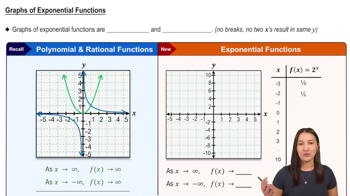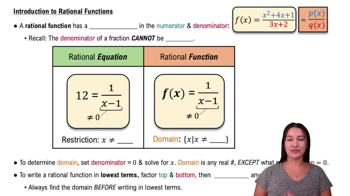Table of contents
- 0. Functions7h 52m
- Introduction to Functions16m
- Piecewise Functions10m
- Properties of Functions9m
- Common Functions1h 8m
- Transformations5m
- Combining Functions27m
- Exponent rules32m
- Exponential Functions28m
- Logarithmic Functions24m
- Properties of Logarithms34m
- Exponential & Logarithmic Equations35m
- Introduction to Trigonometric Functions38m
- Graphs of Trigonometric Functions44m
- Trigonometric Identities47m
- Inverse Trigonometric Functions48m
- 1. Limits and Continuity2h 2m
- 2. Intro to Derivatives1h 33m
- 3. Techniques of Differentiation3h 18m
- 4. Applications of Derivatives2h 38m
- 5. Graphical Applications of Derivatives6h 2m
- 6. Derivatives of Inverse, Exponential, & Logarithmic Functions2h 37m
- 7. Antiderivatives & Indefinite Integrals1h 26m
- 8. Definite Integrals4h 44m
- 9. Graphical Applications of Integrals2h 27m
- 10. Physics Applications of Integrals 2h 22m
1. Limits and Continuity
Finding Limits Algebraically
Problem 72a
Textbook Question
Analyze lim x→∞ f(x) and lim x→−∞ f(x), and then identify any horizontal asymptotes.
f(x) = (√(16x4 + 64x2) + x2) / (2x2 − 4)
 Verified step by step guidance
Verified step by step guidance1
Step 1: Simplify the expression inside the square root. Notice that the dominant term inside the square root as x approaches infinity is 16x^4. Factor out x^4 from the square root: \( \sqrt{16x^4 + 64x^2} = x^2\sqrt{16 + \frac{64}{x^2}} \).
Step 2: Simplify the expression for f(x) by dividing the numerator and the denominator by x^2, the highest power of x in the denominator: \( f(x) = \frac{x^2\sqrt{16 + \frac{64}{x^2}} + x^2}{2x^2 - 4} = \frac{x^2(\sqrt{16 + \frac{64}{x^2}} + 1)}{2x^2 - 4} \).
Step 3: Evaluate the limit as x approaches infinity. As x approaches infinity, \( \frac{64}{x^2} \) approaches 0, so \( \sqrt{16 + \frac{64}{x^2}} \) approaches \( \sqrt{16} = 4 \). Therefore, the expression simplifies to \( \frac{x^2(4 + 1)}{2x^2 - 4} = \frac{5x^2}{2x^2 - 4} \).
Step 4: Simplify the expression \( \frac{5x^2}{2x^2 - 4} \) by dividing the numerator and the denominator by x^2: \( \frac{5}{2 - \frac{4}{x^2}} \). As x approaches infinity, \( \frac{4}{x^2} \) approaches 0, so the expression approaches \( \frac{5}{2} \).
Step 5: Evaluate the limit as x approaches negative infinity. The process is similar to the positive infinity case, and the expression \( \frac{5}{2 - \frac{4}{x^2}} \) also approaches \( \frac{5}{2} \). Therefore, the horizontal asymptote is y = \frac{5}{2}.
 Verified video answer for a similar problem:
Verified video answer for a similar problem:This video solution was recommended by our tutors as helpful for the problem above
Video duration:
3mPlay a video:
Was this helpful?
Key Concepts
Here are the essential concepts you must grasp in order to answer the question correctly.
Limits at Infinity
Limits at infinity involve evaluating the behavior of a function as the input approaches positive or negative infinity. This analysis helps determine the end behavior of the function, which is crucial for identifying horizontal asymptotes. For rational functions, this often involves simplifying the expression by dividing by the highest power of x in the denominator.
Recommended video:

One-Sided Limits
Horizontal Asymptotes
Horizontal asymptotes describe the value that a function approaches as the input approaches infinity or negative infinity. They are determined by the limits of the function at these extremes. If the limit exists and is finite, it indicates the presence of a horizontal asymptote, which can be found by comparing the degrees of the numerator and denominator in rational functions.
Recommended video:

Graphs of Exponential Functions
Rational Functions
Rational functions are expressions formed by the ratio of two polynomials. The behavior of these functions at infinity is influenced by the degrees of the polynomials in the numerator and denominator. Understanding how to simplify these functions and analyze their limits is essential for determining their asymptotic behavior and identifying horizontal asymptotes.
Recommended video:

Intro to Rational Functions

 5:21m
5:21mWatch next
Master Finding Limits by Direct Substitution with a bite sized video explanation from Callie
Start learningRelated Videos
Related Practice







